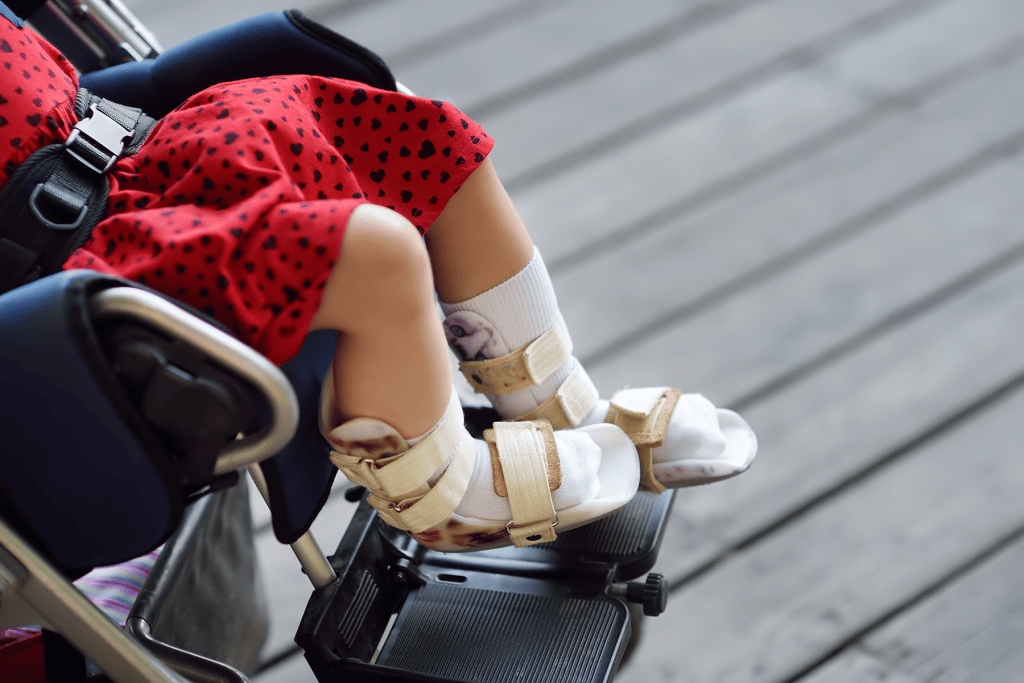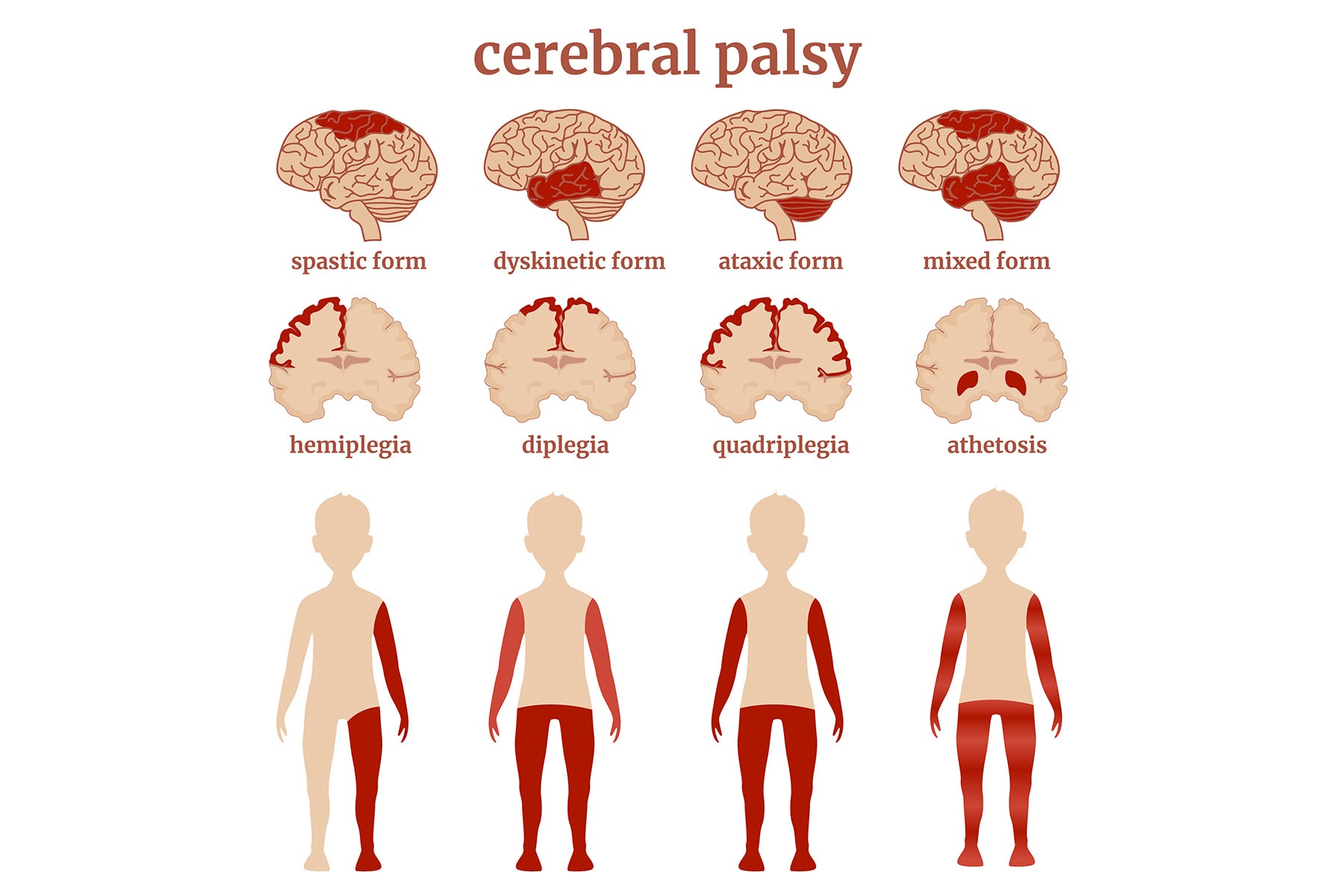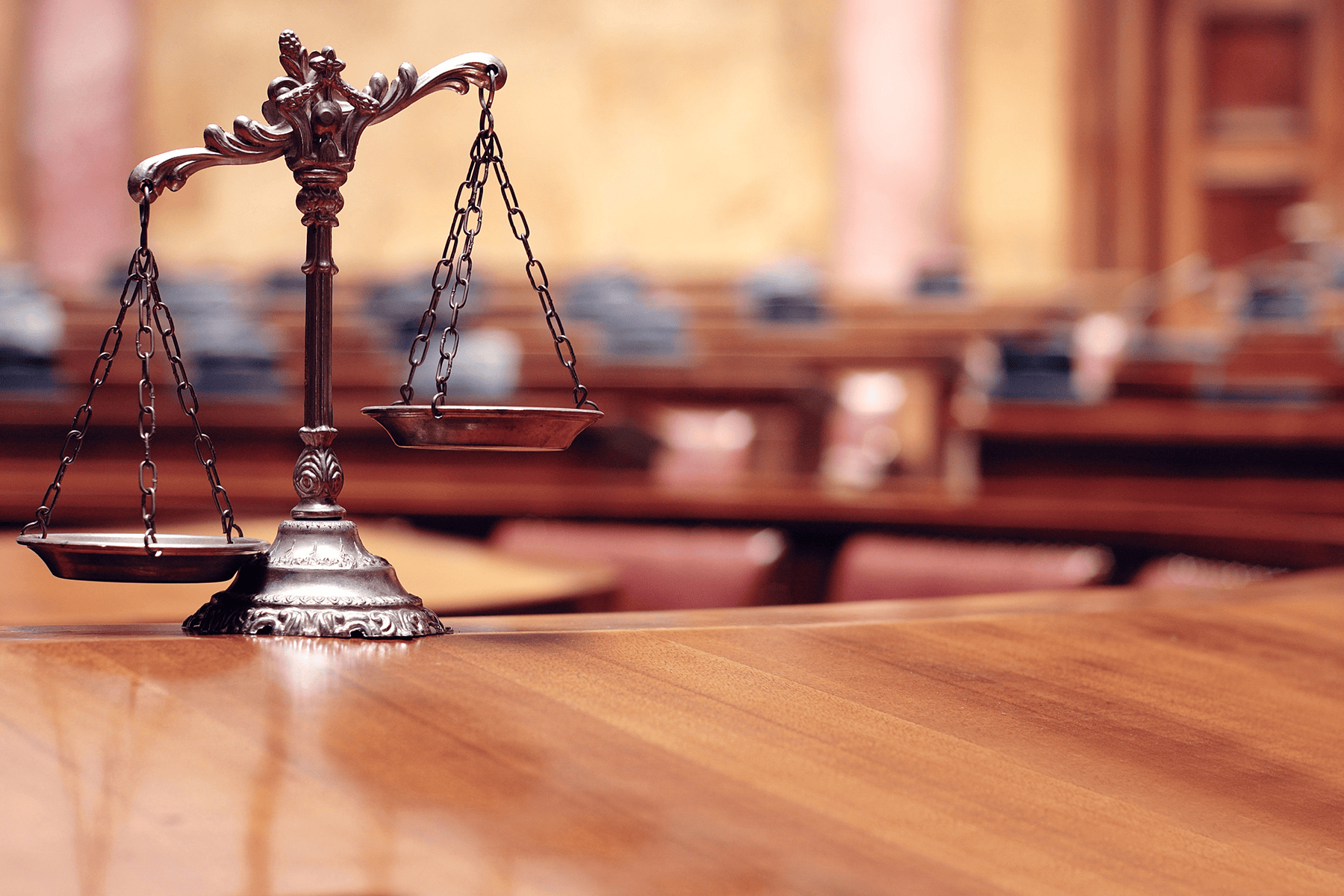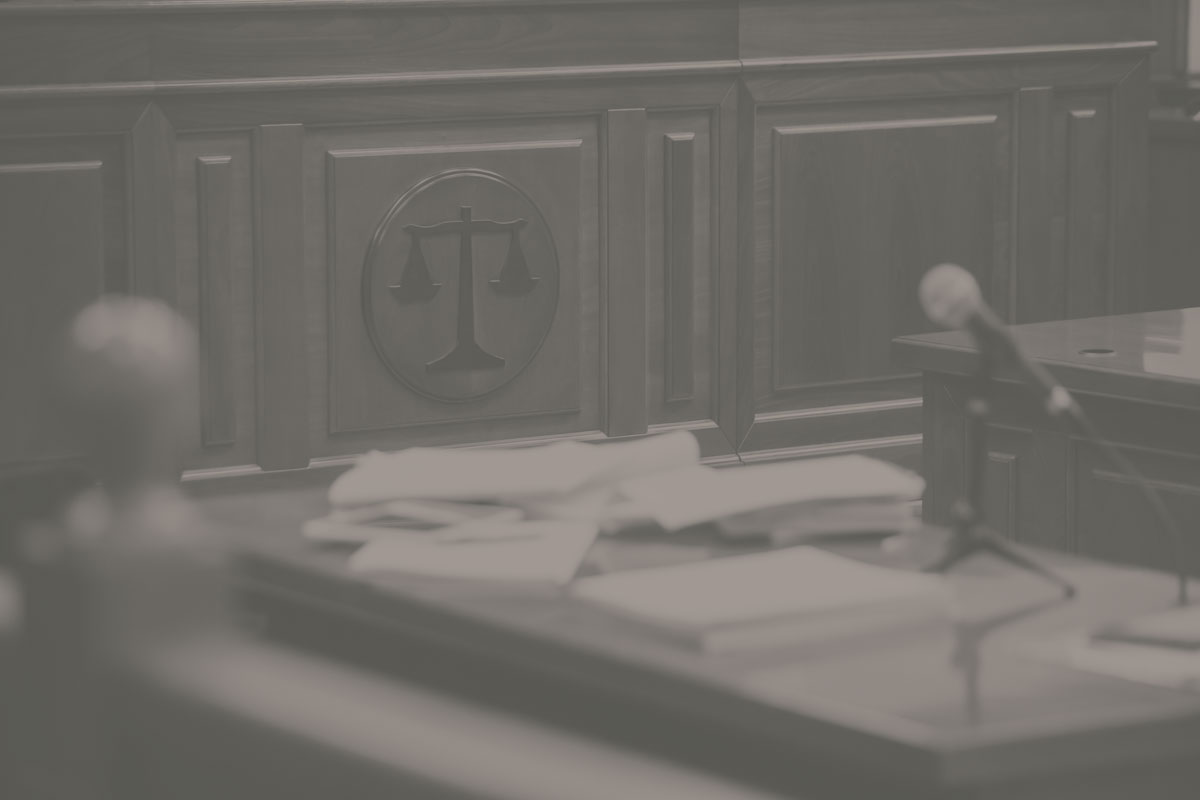Call Today: 312.883.6907
Chicago Cerebral Palsy Lawyer
Did your child or family member experience a birth injury that resulted in cerebral palsy? This can be traumatic and result in severe, life-long consequences. Working with Chicago Medical Malpractice Lawyers is the first step towards getting compensation for your pain.
We’ll work with you to assess your case and the circumstances surrounding it and advise you on all available legal options. Our attorneys understand cerebral palsy and birth injury cases and will take on every aspect of your claim, ensuring that your needs and that you receive compensation for your suffering.

Quicklinks
- Chicago Cerebral Palsy Lawyers: Suffering after a Birth Injury Resulted in Cerebral Palsy?
- What is Cerebral Palsy?
- How Common is Cerebral Palsy?
- How is Cerebral Palsy Defined?
- Our Experience with Cerebral Palsy Lawsuits
- Symptoms of Cerebral Palsy
- Types of Cerebral Palsy
- What Conditions are Comorbid with Cerebral Palsy?
- What Steps Should I Take After a Birth Injury That Resulted in Cerebral Palsy?
- Why Should I Hire a Cerebral Palsy Lawyer?
- What Compensation Can I Expect to Recover in a Cerebral Palsy Case?
- Are Birth Injuries That Cause Cerebral Palsy Considered Medical Malpractice?
- How is a Cerebral Palsy Claim Proven?
- If I or My Child Die, Can My Family Make a Claim?
- How Long Does One Have to File a Cerebral Palsy Lawsuit?
- Is There a Statute of Limitations on Cerebral Palsy Lawsuits in Illinois?
- How Long Does it Take to Receive Compensation for a Cerebral Palsy Claim?
- Find Out if You Have a Cerebral Palsy Case in Chicago, Illinois
Chicago Cerebral Palsy Lawyers: Suffering After A Birth Injury Resulted in Cerebral Palsy?
While you may be devastated after your child has been diagnosed with cerebral palsy and legal action is the last thing on your mind, filing a malpractice lawsuit after experiencing cerebral palsy resulting from a birth injury can be a crucial step towards healing.
It’s a way forward that involves both seeking justice and obtaining compensation for the physical, emotional, and financial toll it takes on both the individual and their family.
Moreover, filing a cerebral palsy malpractice lawsuit serves as a means to obtain financial resources to cover the extensive costs associated with caring for a child with cerebral palsy.
From ongoing medical treatments and therapies to specialized equipment and home modifications, the financial burden can be overwhelming.
Compensation from a successful lawsuit can help alleviate these financial strains, ensuring that the individual with cerebral palsy receives the necessary care and support throughout their life.
Pursuing legal action can also prompt systemic changes within healthcare institutions to prevent similar incidents from occurring in the future.
By holding negligent parties accountable, it sends a clear message about the importance of adhering to proper medical standards and protocols during childbirth.
In fact, filing and winning a lawsuit can even lead to improved training for medical staff, implementation of better monitoring techniques during labor, and overall enhancements in patient safety protocols, ultimately benefiting future patients and their families.
It is a way to protect other families from experiencing the same pain and suffering.

Tell Us About Your Case
Schedule your free case evaluation with Chicago Medical Malpractice Lawyers today
What Is Cerebral Palsy?
Cerebral palsy, a condition that affects muscle movement and coordination, can often be linked to medical negligence during childbirth.
Instances such as a delayed delivery process, improper use of delivery instruments, or failure to respond to fetal distress signals can lead to oxygen deprivation and cause a child’s injuries like brain injuries & damage, resulting in cerebral palsy.
In such cases, families may choose to pursue legal action to hold the responsible medical professionals or institutions accountable for their negligence.

How Common Is Cerebral Palsy?
Cerebral palsy is the most common motor disability in childhood. According to the Centers for Disease Control and Prevention, it affects approximately 1 in every 345 children in the United States.
Globally, the prevalence of cerebral palsy varies by region and access to healthcare, but estimates suggest that it affects between 1.5 to more than 4 per 1,000 live births worldwide.
While cerebral palsy is not considered a progressive condition, meaning the brain injury does not worsen over time, its impact on an individual’s motor function, muscle control, and coordination can vary widely.
Some individuals may experience mild symptoms and have relatively independent lives, while others may have more severe impairments requiring extensive medical care and support.
Various factors can contribute to the development of cerebral palsy, including prenatal factors such as maternal infections, HIE stages, genetic conditions, and certain complications during pregnancy, as well as perinatal factors such as premature birth, low birth weight, and birth injuries.
Identifying and addressing these risk factors through improved prenatal care, medical interventions during childbirth, and early childhood interventions can help reduce the incidence of cerebral palsy and improve outcomes for affected individuals.
How Is Cerebral Palsy Defined?
Legally, cerebral palsy is typically defined as a neurological condition characterized by a permanent movement disorder that arises from damage to a baby’s developing brain, often occurring before, during, or shortly after birth.
In legal contexts, cerebral palsy is recognized as a form of birth injury, and its definition may vary depending on jurisdiction and applicable laws.
In general, to establish a legal definition of cerebral palsy in the context of a malpractice lawsuit, certain criteria must often be met.
These criteria may include demonstrating that the condition was caused by medical negligence or improper medical care during childbirth, such as failure to monitor fetal distress & fetal vital signs, a delayed labor and delivery process, or improper use of delivery instruments like forceps.
It may also be necessary to provide evidence that the resulting birth injury caused brain damage was a direct result of a medical wrong diagnosis, negligent actions, or omissions of medical professionals.
Legal definitions of cerebral palsy may also encompass the impact the condition has on the individual’s life, including physical limitations, cognitive impairments, and ongoing medical needs.
This broader definition helps determine the extent of damages in a malpractice case, including compensation for medical expenses, pain and suffering, loss of earning capacity, and other related costs.

Our Experience With Cerebral Palsy Lawsuits
We’re a Chicago-based law firm specializing in medical malpractice with extensive experience representing clients in cases involving cerebral palsy resulting from birth injuries.
Our lawyers at Chicago Medical Malpractice Lawyers have successfully litigated numerous cases where patients suffered harm due to cerebral palsy caused by birth injuries or similar trauma, successfully securing compensation for medical expenses, lost wages, and pain and suffering.
Our expertise in this area often involves collaborating with medical experts to uncover negligence and advocate for their clients’ rights.
We focus on clients in Chicago, Illinois, and the surrounding areas and offer a free consultation to hear your case.
Some examples of our medical malpractice lawsuit cases we’ve handled include settlements of $1.25 million for an undisclosed negligent failure.
Symptoms Of Cerebral Palsy
The symptoms of congenital cerebral palsy can vary widely depending on the severity and location of the brain injury or head injury, but commonly include impaired muscle control and coordination, muscle stiffness or spasticity, scissor legs, involuntary movements, and abnormal gait patterns.
Individuals with cerebral palsy may also experience difficulties with balance, fine motor skills, and posture, as well as challenges with speech and swallowing.
Cognitive impairments, such as learning disabilities or intellectual disabilities, may also be present in some cases.
The symptoms of cerebral palsy typically manifest early in life, often becoming apparent during infancy or early childhood.
They may change or become more pronounced as the individual grows and develops.
Early intervention and ongoing occupational therapy can help manage symptoms and improve the quality of life for individuals with cerebral palsy.
Causes Of Cerebral Palsy
Cerebral palsy can be caused by factors such as abnormal brain development during fetal development due to infections or genetic abnormalities, as well as perinatal complications like oxygen deprivation during labor and delivery, birth assisting tools, premature birth, or low birth weight.
Postnatal factors such as baby’s brain trauma, infections, and certain medical conditions can also contribute to the development of cerebral palsy.
These various factors can disrupt the normal development of the brain’s motor control centers, leading to impairments in muscle coordination, movement, and posture characteristic of cerebral palsy.

Types Of Cerebral Palsy
Cerebral palsy has 4 main types, each characterized by different patterns of movement impairment and muscle tone.

Spastic Cerebral Palsy
Spastic cerebral palsy is a type of cerebral palsy characterized by increased muscle tone, resulting in stiffness and difficulty controlling movements.
This stiffness, known as spasticity, can affect one or multiple limbs, or even the entire body, depending on the severity of the condition.
People with spastic cerebral palsy may experience muscle tightness, exaggerated reflexes, and jerky or stiff movements, making it challenging to perform daily activities such as walking, reaching, or grasping objects.
Spastic cerebral palsy is the most common type of cerebral palsy, accounting for approximately 75-85% of all cases, and it can vary in severity from mild to severe, impacting individuals differently depending on the extent of brain injury and affected areas.
Hemiplegic Cerebral Palsy
Hemiplegic cerebral palsy is a type of cerebral palsy characterized by weakness or paralysis on one side of the body.
It occurs due to damage to the developing brain, usually before, during, or shortly after birth.
The term “hemiplegic” indicates that the paralysis affects one half of the body, typically either the left or right side.
You may see this condition referred to as “left hemiplegic cerebral palsy” or “right hemiplegic cerebral palsy”.
This condition can manifest in various ways, including difficulties with movement and coordination on the affected side, muscle stiffness or spasticity, and challenges with fine motor skills.
The severity of symptoms can vary widely from person to person, ranging from mild to severe.
Dyskinesia Cerebral Palsy
Dyskinetic cerebral palsy, also known as athetoid or dyskinetic-athetoid cerebral palsy, is a subtype of cerebral palsy characterized by involuntary, uncontrolled movements.
These movements can be writhing, twisting, or jerking in nature and typically affect the arms, legs, face, and trunk.
Individuals with dyskinetic cerebral palsy may have difficulty maintaining posture and coordinating movements, leading to challenges with tasks requiring fine motor skills such as writing, feeding, or speaking.
This form of cerebral palsy often results from damage to the basal ganglia, a part of the brain involved in controlling voluntary movements.
Dyskinetic cerebral palsy accounts for approximately 10-20% of all cerebral palsy cases and can vary widely in severity, with some individuals experiencing mild symptoms while others may have more profound impairments.
Axtaxic Cerebral Palsy
Ataxic cerebral palsy is a form of cerebral palsy characterized by difficulties with balance, coordination, and depth perception.
Individuals with ataxic cerebral palsy often have shaky movements, particularly when attempting precise motor tasks such as reaching for objects or writing.
They may also experience problems with gait, often walking with a wide-based stance and unsteady movements.
Ataxic cerebral palsy is less common than other types, accounting for approximately 5-10% of all cases of cerebral palsy.
It typically results from damage to the cerebellum, the part of the brain responsible for coordinating movement and balance.
While individuals with ataxic cerebral palsy may face challenges with motor skills, they often have relatively preserved cognitive abilities compared to other forms of cerebral palsy.

What Conditions Are Comorbid With Cerebral Palsy?
Cerebral palsy can be comorbid with various medical conditions and disabilities, which may further complicate the individual’s health and care needs.
Some common comorbidities associated with cerebral palsy include:
- Intellectual Disabilities. Many individuals with cerebral palsy may also have intellectual disabilities, ranging from mild to severe, affecting cognitive functioning, learning abilities, and adaptive skills. About 1 in 10 children with cerebral palsy also have autism spectrum disorder.
- Epilepsy. Seizure disorders, such as epilepsy, are more prevalent among individuals with cerebral palsy. Seizures can further impact quality of life and require additional management and treatment. About 1 in 4 children with cerebral palsy also have epilepsy.
-
Speech And Communication Disorders. Difficulties with speech and communication are common in individuals with cerebral palsy due to motor impairments affecting the muscles involved in speaking. This can include conditions like dysarthria or apraxia of speech.
-
Vision And Hearing Impairments. Some individuals with cerebral palsy may also experience vision or hearing impairments, which can affect their ability to interact with the environment and require specialized interventions and support.
-
Musculoskeletal Issues. Conditions such as scoliosis (abnormal curvature of the spine), joint contractures, and muscle contractures are common comorbidities in cerebral palsy due to muscle imbalance, spasticity, and impaired mobility.
-
Gastrointestinal Problems. Digestive issues, including feeding difficulties, gastroesophageal reflux disease (GERD), constipation, and aspiration, are often seen in individuals with cerebral palsy, necessitating careful monitoring and management.
-
Respiratory Complications. Weakness of respiratory muscles, aspiration, or respiratory infections can lead to respiratory complications such as pneumonia or chronic lung disease, particularly in individuals with severe cerebral palsy or significant motor impairments.
What Steps Should I Take After A Birth Injury That Resulted In Cerebral Palsy?
Experiencing a birth injury that resulted in cerebral palsy can be devastating, but there are some key steps you can take to seek justice, support, and necessary care that include:
-
Documenting Everything. Keep detailed records of your child’s medical history, including prenatal care, labor and delivery records, and postnatal evaluations. Document any symptoms, diagnoses, treatments, and ongoing care received by your child.
-
Consulting With Legal Professionals. Consider consulting with a lawyer experienced in medical malpractice and birth injury cases. They can help you understand your legal rights, assess the circumstances surrounding the birth injury, and determine if pursuing legal action is appropriate.
-
Gathering Evidence. Work with your lawyer to gather evidence to support your case, including medical records, expert opinions, witness statements, and any documentation related to the child’s injury and subsequent cerebral palsy diagnosis.
-
Understanding Your Options. Discuss with your lawyer the potential outcomes of pursuing a malpractice lawsuit, including the possibility of seeking financial compensation to cover medical expenses, ongoing care, speech therapy, and other related costs.
-
Accessing Support Services. Seek out support services and resources available for families affected by cerebral palsy, including support groups, advocacy organizations, and community programs that can provide emotional support, information, and assistance navigating healthcare and educational systems.
-
Advocating For Your Child. Be a strong advocate for your child’s needs, ensuring they receive appropriate medical care, physical therapy, education, and support services to maximize their potential and quality of life.
Remember that every case is unique, and the steps you take will depend on your individual circumstances.
It’s essential to surround yourself with a supportive network of healthcare professionals, legal experts, and loved ones as you navigate this challenging journey.

Why Should I Hire A Cerebral Palsy Lawyer?
Hiring a Chicago birth injury lawyer after your child suffers an injury resulting in cerebral palsy is essential for several reasons.
Your lawyer will have the expertise and experience in navigating complex medical malpractice and birth injury cases, including understanding the intricate medical evidence and legal principles involved.
Specialized birth injury lawyers can assess the details of your case, determine if medical negligence contributed to your child’s cerebral palsy birth injury, and advocate on your behalf to seek justice and fair compensation.
Your attorney can also guide you through the legal process, handle negotiations with insurance companies and medical professionals, and ensure that your rights and interests are protected every step of the way, ultimately providing you with the best chance of achieving a favorable outcome for your child’s future care and well-being.
What Compensation Can I Expect To Recover In A Cerebral Palsy Case?
In a cerebral palsy case, the compensation that can be pursued typically encompasses various categories aimed at addressing the physical, emotional, and financial impacts of the personal injury.
Economic Damages For Cerebral Palsy
Economic damages for cerebral palsy typically include compensation for medical expenses, such as doctor’s visits, surgeries, therapy, medications, and assistive devices, as well as future medical costs and lost earning capacity for caregivers due to the child’s condition.
These damages aim to cover the financial burden associated with caring for a child with cerebral palsy and ensuring they receive the necessary support and resources throughout their life.
Non-Economic Damages For Cerebral Palsy
Non-economic damages for cerebral palsy encompass compensation for pain and suffering, emotional distress, loss of enjoyment of life, child’s ability limitations, and the impact of the condition on the child’s quality of life and relationships.
These damages recognize the intangible losses experienced by the child and their family due to the challenges and limitations imposed by cerebral palsy, aiming to provide some measure of solace and recognition for their hardships.
Are Birth Injuries That Cause Cerebral Palsy Considered Medical Malpractice?
Birth injuries that lead to cerebral palsy can indeed be considered medical malpractice if they result from negligent actions or medical error omissions by healthcare providers during pregnancy, labor, or delivery.
Examples of medical negligence contributing to birth injuries and subsequent cerebral palsy may include failure to diagnose fetal distress, improper use of delivery instruments, delays in performing necessary medical interventions, or administering incorrect medications.
Families affected by such circumstances may have grounds for pursuing a medical malpractice claim to seek compensation for the harm caused to their child and the associated emotional and financial burdens.

How Is A Cerebral Palsy Claim Proven?
Proving a cerebral palsy claim typically involves gathering medical evidence, expert testimony, and other documentation to establish that the condition was caused by medical negligence or malpractice.
Here’s a general overview of the process and the steps involved in proving a cerebral palsy claim:
-
Medical Records Review. The first step is to gather all relevant medical records related to the pregnancy, labor, and delivery, as well as the child’s subsequent medical history. These records will be thoroughly reviewed to identify any instances of negligence or substandard care that may have contributed to the development of cerebral palsy.
-
Expert Evaluation. Expert medical opinions are crucial in cerebral palsy claims. Medical experts, such as obstetricians, neonatologists, pediatric neurologists, and other specialists, may be consulted to review the medical records and provide their opinion on whether negligence occurred and whether it likely led to the child’s cerebral palsy.
-
Causation. Establishing causation is key in proving a cerebral palsy claim. This involves demonstrating that the negligent actions or omissions of healthcare providers directly caused or significantly contributed to the child’s cerebral palsy. Expert testimony and medical evidence play a critical role in establishing this causal link.
-
Documentation Of Damages. In addition to proving causation, it’s important to document the damages suffered by the child and their family as a result of the cerebral palsy. This may include medical expenses, ongoing medical care and therapy costs, lost earning capacity, pain and suffering, and other related damages.
-
Legal Proceedings. If a settlement cannot be reached with the healthcare provider or institution responsible for the negligence, a cerebral palsy claim may proceed to litigation. During this process, both sides present their evidence and arguments in court, and a judge or jury ultimately decides the outcome of the case.
If I Or My Child Die, Can My Family Make A Claim?
Yes, your family may still be able to make a claim for wrongful death.
Wrongful death claims can be pursued against healthcare providers or institutions if it can be shown that the death was caused by medical malpractice or negligence.
These claims seek compensation for the damages suffered by the surviving family members, including funeral and burial expenses, loss of financial support, and emotional pain and suffering resulting from the loss of a loved one.
Wrongful death claims are complex and vary depending on jurisdiction, so consulting with a knowledgeable attorney experienced in medical malpractice law is crucial to understand your legal options and pursue the appropriate course of action.
How Long Does One Have To File A Cerebral Palsy Lawsuit?
Proving a cerebral palsy claim typically involves demonstrating that the child’s condition resulted from medical negligence during pregnancy, labor, or delivery.
This process often requires gathering extensive medical records, expert opinions from healthcare professionals specializing in obstetrics and neurology, and other relevant evidence.
Establishing a causal link between the negligent actions or omissions of healthcare providers and the resulting birth injury and cerebral palsy is essential in substantiating the claim and securing compensation for the affected child and their family.
Is There A Statute Of Limitations On Cerebral Palsy Lawsuits In Illinois?
In Chicago and elsewhere in Illinois, the statute of limitations for general medical malpractice claims is 2 years from the date of the alleged negligent act or omission, or from the date the personal injury was discovered or should have been discovered with reasonable diligence, but no longer than 4 years from the date of the alleged negligence.
For cerebral palsy-related birth injury claims in Illinois, the statute of limitations for filing a birth injury claim is typically within 8 years of the date of the injury, or before the child’s 22nd birthday, whichever is later.
However, there are exceptions and variations depending on the specific circumstances of the case, so it’s crucial to consult with a qualified attorney experienced in medical malpractice law in Illinois to understand how the statute of limitations applies to your particular situation.
How Long Does It Take To Receive Compensation For A Cerebral Palsy Claim?
The timeline for receiving compensation for a cerebral palsy claim can vary significantly depending on various factors, including the complexity of the case, the willingness of the parties to negotiate, and the legal procedures involved.
In some instances, a settlement may be reached relatively quickly, particularly if liability is clear, and the parties agree on the amount of compensation.
However, if the case goes to trial or encounters challenges during negotiations, it could take significantly longer, potentially several years, before compensation is awarded.

Definitions And Background Information On Cerebral Palsy Lawsuits
-
What is cerebral palsy?
Cerebral palsy is a neurological disorder that affects movement, muscle coordination, and posture, often caused by brain damage occurring before, during, or shortly after birth.
-
What are the risk factors for cerebral palsy?
Risk factors for cerebral palsy include premature birth, low birth weight, multiple births or pregnancies (such as twins or triplets), maternal infections during pregnancy, birth complications, and certain genetic factors.
-
What are the most common types of cerebral palsy?
The two most common types of cerebral palsy are spastic cerebral palsy, characterized by muscle stiffness and tightness, and dyskinetic cerebral palsy, characterized by involuntary and uncontrolled movements.
Ataxic cerebral palsy, characterized by difficulties with balance and depth perception, occurs more rarely.
How long do you have to file a claim for cerebral palsy?
The statute of limitations for filing a claim for cerebral palsy caused by a birth injury varies by jurisdiction but typically ranges from one to several years after the injury or from the date the injury was discovered or should have been discovered.
In Illinois, you have 8 years from the date of the injury, or before the child’s 22nd birthday (whichever is later) to file a claim.
-
Can you file a claim against a doctor for cerebral palsy?
Yes, you can file a medical malpractice claim against a doctor if their negligent actions or omissions during pregnancy, labor, or delivery contributed to the child developing cerebral palsy.
-
Can you file a claim against a hospital for cerebral palsy?
Yes, you can file a medical malpractice claim against a hospital if its negligence, such as inadequate staffing, failure to monitor fetal distress, or improper use of medical equipment, contributed to the child developing cerebral palsy.
-
Can you file a claim against an emergency room for cerebral palsy?
Yes, you can file a medical malpractice claim against an emergency room if their negligent actions or failure to provide appropriate care during childbirth contributed to the child developing cerebral palsy.
-
Will a confirmation of cerebral palsy automatically lead to a valid legal claim against the health care provider?
A confirmation or diagnosis of cerebral palsy alone may not automatically lead to a valid legal claim against the healthcare provider, as it requires demonstrating that the condition resulted from the healthcare provider’s negligence or improper medical care during pregnancy, labor, or delivery.
However, a confirmed diagnosis of cerebral palsy can be a critical piece of evidence in building a medical malpractice case if there is evidence that medical malpractice occurred and contributing to the child’s condition.
-
What are the long term impacts of cerebral palsy?
The long-term impacts of cerebral palsy can vary widely depending on the severity and type of the condition, but they often include lifelong challenges with mobility, muscle coordination, and daily activities.
Individuals with cerebral palsy may require ongoing medical care, therapies, assistive devices, and accommodations to manage their condition and maximize their quality of life.
Cerebral palsy can also affect social interactions, educational opportunities, and employment prospects, leading to significant emotional and socioeconomic impacts throughout the individual’s life.
-
If my child dies as a result of cerebral palsy, will the claim die as well?
If a child dies as a result of cerebral palsy, the claim may still proceed as a wrongful death lawsuit on behalf of the child’s estate and surviving family members, depending on the circumstances and applicable laws.
How long do I have to file a lawsuit for a cerebral palsy case, and how long is it likely to take before I receive compensation?
The time limit to file a lawsuit for cerebral palsy varies by jurisdiction, typically ranging from one to six years, while the duration to receive compensation can vary significantly depending on factors such as case complexity and negotiations, potentially taking months to several years.
In Illinois, the statute of limitations for filing a birth injury claim (including cerebral palsy) is typically within 8 years of the date of the injury, or before the child’s 22nd birthday, whichever is later.
-
Does Illinois apply any limits on medical malpractice damages?
Illinois does not have statutory limits or caps on medical malpractice damages, meaning there is no cap on the amount of compensation that can be awarded for economic or non-economic damages in medical malpractice cases.
However, it’s essential to consult with a legal professional or check for any updates in the law prior to making a claim, as regulations can change over time.
-
How much compensation can I receive in a cerebral palsy lawsuit?
The amount of compensation you can receive in a cerebral palsy lawsuit in Illinois and elsewhere varies widely depending on factors such as the severity of the injury, the long-term impact on the child and family, medical expenses, lost income, and pain and suffering.
Settlements or jury awards can range from thousands to millions of dollars.
Consulting with a qualified attorney who specializes in cerebral palsy cases in your area can provide a better estimate based on the specific circumstances of your case.
-
What to do if you think you have experienced a birth injury that resulted in cerebral palsy?
If you or your child have suffered a birth injury resulting in cerebral palsy, consider seeking a second opinion from another healthcare provider, gather all relevant medical records and documentation, and consult with a qualified medical malpractice attorney to explore your legal options.
-
How do you prove a birth injury resulting in cerebral palsy occurred?
Proving that a birth injury occurred and resulted in cerebral palsy involves gathering medical records, consulting with medical experts, and conducting a thorough review of the circumstances surrounding the childbirth process.
Medical evidence such as diagnostic tests, imaging studies, and expert testimony can help establish the extent of the injury and its likely cause.
Documenting any deviations from the accepted standard of care, such as errors in medical judgment or failure to respond appropriately to complications during labor and delivery, is crucial in demonstrating medical negligence and establishing liability for the birth injury and consequent cerebral palsy.
-
When a cerebral palsy is listed on an insurance claim form, what will happen?
When cerebral palsy is listed on an insurance claim form, the insurance company will typically review the claim to assess liability and determine coverage.
Depending on the circumstances, they may conduct their own investigation, request additional information or documentation, and may ultimately approve or deny the claim based on the terms of the policy and their assessment of the situation.
If the claim is approved, the insurance company may provide compensation to cover medical expenses and other damages resulting from cerebral palsy, subject to the limits of the policy and any applicable deductibles or copays.
If the claim is denied, the claimant may have the option to appeal the decision or pursue other avenues for seeking compensation, such as filing a lawsuit against the responsible parties.
-
How many cases of cerebral palsy are there per year?
The exact number of cases of cerebral palsy diagnosed per year can vary depending on factors such as geographic location, access to healthcare, and reporting practices, but estimates suggest that there are approximately 1.5 to more than 4 per 1,000 live births globally.
-
My doctor caused a birth injury and my child has been diagnosed with cerebral palsy. Now what?
If you believe your doctor caused a birth injury that resulted in cerebral palsy, the first step is to seek immediate medical attention for your child to address any immediate medical needs.
It’s also essential to gather and organize all relevant medical records and documentation related to the childbirth process and the injury sustained.
Next, consult with a qualified attorney experienced in medical malpractice and cerebral palsy cases in your jurisdiction to discuss your legal options.
Your attorney can help you understand your rights, navigate the legal process, and pursue compensation for the damages incurred as a result of the birth injury and subsequent cerebral palsy, including medical expenses, pain and suffering, and other losses.
Can you file a claim for cerebral palsy?Yes, you can file a claim for cerebral palsy if you believe that the injury resulted from medical negligence or malpractice during prenatal care, labor, or delivery. Filing a claim allows you to seek compensation for the damages incurred as a result, including medical expenses, pain and suffering, and other losses. It’s advisable to consult with a qualified attorney experienced in medical malpractice and cerebral palsy cases in your area to understand your legal rights and options for pursuing a claim.

Find Out If You Have A Cerebral Palsy Case In Chicago, Illinois
Do you think you have a medical malpractice case based on a birth injury resulting in cerebral palsy that occurred in Illinois?
If you are located in Chicago or the surrounding areas, contact the experienced firm at Chicago Medical Malpractice Lawyers for a free consultation today.
Tell Us About Your Case
Legally Reviewed By

Adam J. Zayed
Adam J. Zayed, the founder and managing trial attorney of Chicago Medical Malpractice Lawyers, and a nationally recognized and award-winning personal injury and medical malpractice trial attorney.

Chicago Medical Malpractice Lawyers
833 W Chicago Ave., Suite 303
Chicago, IL 60642
Tel: 312.883.6907
Fax: 312.481.7927
